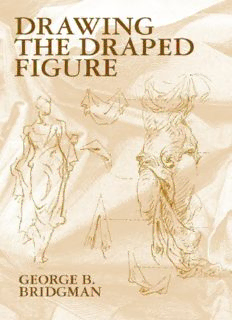
Drawing the Draped Figure: The Seven Laws of Folds PDF
Preview Drawing the Draped Figure: The Seven Laws of Folds
PUBLISHER’S NOTE George Bridgman is considered by some to have been the greatest teacher of figure drawing of his day. An inspiration to generations of students in his classes at the Art Students League in New York, he taught thousands more through his many books, of which Drawing the Draped Figure is the sixth to be published by Dover. These books are proving as popular now as when they were first published. Read together, they make a complete course in the representation of the human form in classical style. Published in the United Kingdom by David & Charles, Brunel House, Forde Close, Newton Abbot, Devon TQ12 4PU. Bibliographical Note This Dover edition, first published in 2001, is an unabridged republication of the original edition published by Bridgman Publishers, Inc., Pelham, New York, under the title The Seven Laws of Folds in 1942. Library of Congress Cataloging-in-Publication Data Bridgman, George Brant, 1864–1943. Drawing the draped figure : The seven laws of folds / George B. Bridgman. p. cm. Originally published: The seven laws of folds. 1st ed. Pelham, N.Y. : Bridgman Publishers, 1942. 9780486138121 1. Drapery in art. 2. Figure drawing—Technique. I. Title: Seven laws of folds. II. Bridgman, George Brant, 1864–1943. Seven laws of folds. III. Title. NC775 .B7 2001 743.5—dc21 2001028649 Manufactured in the United States of America Dover Publications, Inc., 31 East 2nd Street, Mineola, N.Y. 11501 FOREWORD CLOTHING is none other than drapery arranged around a body that is beneath it. To express the multitudinous forms it takes, one should learn to express in a direct way the different characters of folds, for each one plays its individual part as distinctly apart as actors play their different characters upon the stage. Folds are totally different. There are those which pass around and radiate from the points of support, clasping the figure there-by reducing the receding surface to a minimum or they may zigzag in an irregular manner from side to side. There are folds which are straight, festooned and V shaped; folds which fall, cross or pass around the figure. There are materials which have concave and convex forms as well as cord-like edges. All folds have laws unto themselves. Some folds run into their opponents and die away while there are others which terminate abruptly. Each individual fold has its own manner, its temperament and almost its religion. Each pursues its function so that each must be studied apart as a fixed law, a thing entirely apart, without connection, yet held throughout by the unforeseen laws of rhythm. As you would study the surface or an arm and forearm, or a thigh and a leg and their connection at the elbow or at the knee joints, these folds must come together, linked as they pass around or into one another. To do so, a name indicating a function must be given to each. 1. PIPE 2. ZIGZAG 3. SPIRAL 4. HALF-LOCK 5. DIAPER PATTERN 6. DROP 7. INERT In the following pages it is hoped that their meaning will be made clear. DEDICATED TO ELEANOR BLAIR Table of Contents Title Page Copyright Page FOREWORD Dedication RHYTHM THE SEVEN LAWS OF FOLDS DRAPERY THE DIFFERENT CHARACTERS OF FOLDS PIPE OR DROP FOLDS ZIGZAG FOLDS SPIRAL ARRANGEMENT DIAPER PATTERN HALF-LOCK FOLD DIAPER DROP-FOLD INERT LOCK FOLD KNEE VOLUME DROP AND FLYING FOLDS HALF-LOCK ARRANGEMENT OF FOLDS ARM AND FOREARM DRAPED FIGURE RHYTHM THE arrangement of line and volume of folds is not complete or harmonious THE arrangement of line and volume of folds is not complete or harmonious without a hidden and subtle flow of symmetry. Nature has supplied both line and form that are symmetrical and harmonious. These laws of rhythm exist and are recognized as undefined laws. There is rhythm in the movement of the sea and tides, in stars and planets, in trees and grasses, clouds and thistledown. It is a part of all animal and plant life. It is the movement of uttered words expressed in their accented and unaccented syllables and in the grouping and pauses of speech. Both poetry and music are the embodiment in appropriate rhythmical sound; of beautiful thought; imagination or emotion. Without rhythm there could be no poetry or music. In drawing and painting there is rhythm in outline, color, light and shade. So to express rhythm in drawing a figure we have in the balance of masses, a subordination of the passive or inactive side, to the more forceful and angular side in action, keeping constantly in mind the hidden, subtle flow of symmetry throughout.
Description: